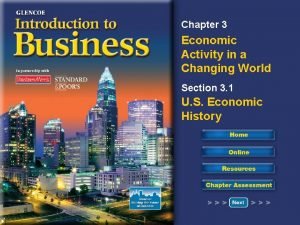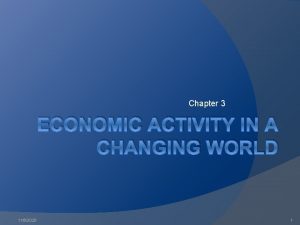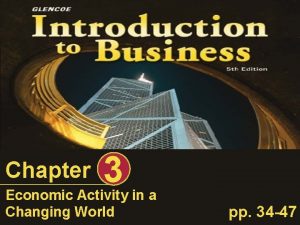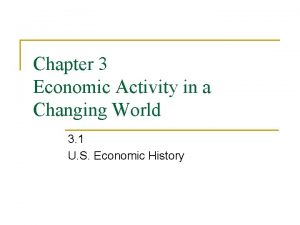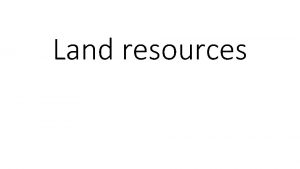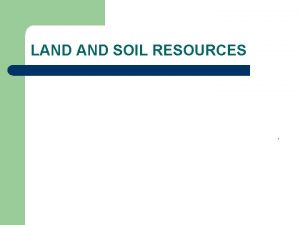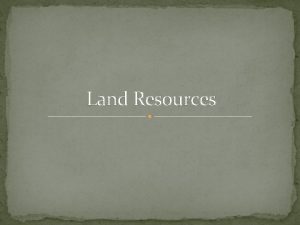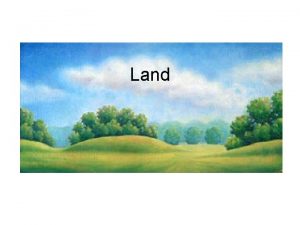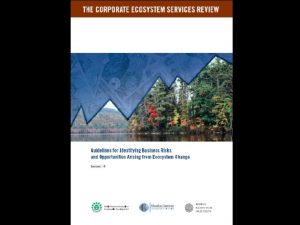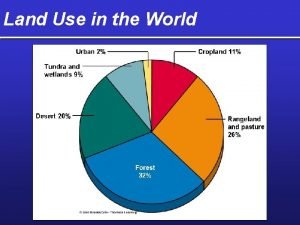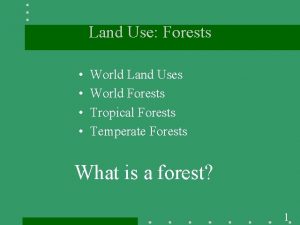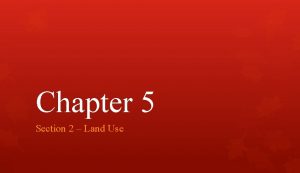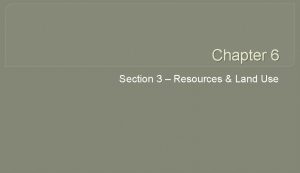Resources and Land Use World Economic Activity Section










- Slides: 10

Resources and Land Use World Economic Activity Section Two

Economic Activities n n 1. 2. 3. 4. People acquire things they need and the luxuries they desire by engaging in many different activities. Geographic economists classify these economic activities into four categories: Primary Economic Activities Secondary Economic Activities Tertiary Economic Activities Quaternary Economic Activities

Primary Activities n n n n These are activities that rely primarily on natural resources. Examples are: fishing, forestry, mining, farming, hunting, gathering herding. Hunting, gathering and herding are mostly ancient forms of primary economic activity. Farming is the most widespread and important form of primary economic activity today. Subsistence farming is used in developing nations. Only enough food is grown for the family or village. Food is grown to eat, not to sell. Commercial farming uses modern techniques and equipment. Small numbers of workers can produce large amounts of food to sell. Commercial fishing is also widely practiced in the world. Commercial farming and fishing is mostly used in the developed or industrialized world.

Secondary Activities n n n This is when people use raw materials to produce or manufacture new products of greater value. Examples are: processing wheat into flour, milling lumber into plywood, and producing electrical power. In subsistence economies, secondary activities are small in scale and do not use advanced technology. These are called cottage industries. This involves items produced by hand. In more advanced economies, hundreds of thousands of people work in large factories near major cities. These are called commercial industries. They turn out large quantities of manufactured goods such as: clothing, automobiles, household appliances, and heavy machinery. Factories are built either near raw materials, near markets where the products will be sold or near cheap labor sources, or areas with low energy or transportation costs.

Tertiary Activities n n These are service industries. Examples are: lawyers, doctors, salespersons, truck drivers, firefighters, and police officers. People do not directly gather or process raw materials in these activities. These activities are located where services are required. This near where people live and work.

Quaternary Activities n n These are jobs that focus on the acquisition, processing, and sharing of information. Examples are: education, government, information processing, and research. These sorts of activities do not need to be near resources or a market. They are usually located near concentrations of highly educated workers and excellent communication networks. The internet has allowed many of these workers to live anywhere in the world. It has also made this one of the fastest growing categories of economic activity.

Global Trade Patterns n n Each country in the world possesses different types and quantities of resources. When nations do not have all the resources and goods that they want or need, they establish a trading network. The goods that are sent out of the country are called exports. The goods that are brought into the country are called imports.

Trade Balance n n n Governments seek a balance between imports and exports. Too many imports may cause a loss in profits for domestic companies, increase unemployment, and increase debt to foreign nations. Imports are often limited by imposing taxes on foreign made goods.

Trade Routes n n n Trade routes are determined by geography, transportation technology, and international relations. Today modern technology allow for electronic trading to take place. Goods are still transported between nations, but business deals and payments are often made via computer and satellite networks.

Level of Development n n n n Economic activities and trade patterns influence a country’s level of development. Modern industrial societies are said to be developed nations. (United States, Japan, France) Countries with lower levels of prosperity are considered underdeveloped. Countries showing economic or political improvement are considered developing countries. The GDP or Gross Domestic Product is used to compare levels of wealth among nations. The GDP is the total value of goods and services produced in a country in a year, divided by the total population. Developed countries have high GDPs compared to underdeveloped or developing countries. People in developed countries enjoy a higher standard of living, have better transportation and communication networks, and live longer.
 Chapter 3 economic activity in a changing world answer key
Chapter 3 economic activity in a changing world answer key Chapter 3 economic activity in a changing world
Chapter 3 economic activity in a changing world Chapter 3 economic activity in a changing world
Chapter 3 economic activity in a changing world Chapter 3 economic activity in a changing world
Chapter 3 economic activity in a changing world Transformation processes
Transformation processes Fixed and variable resources examples
Fixed and variable resources examples Chapter 2 economic resources and systems
Chapter 2 economic resources and systems Prof. meier and baldwin
Prof. meier and baldwin An area of land largely enclosed by higher land
An area of land largely enclosed by higher land What are landforms
What are landforms Renewable resources vs nonrenewable resources
Renewable resources vs nonrenewable resources
